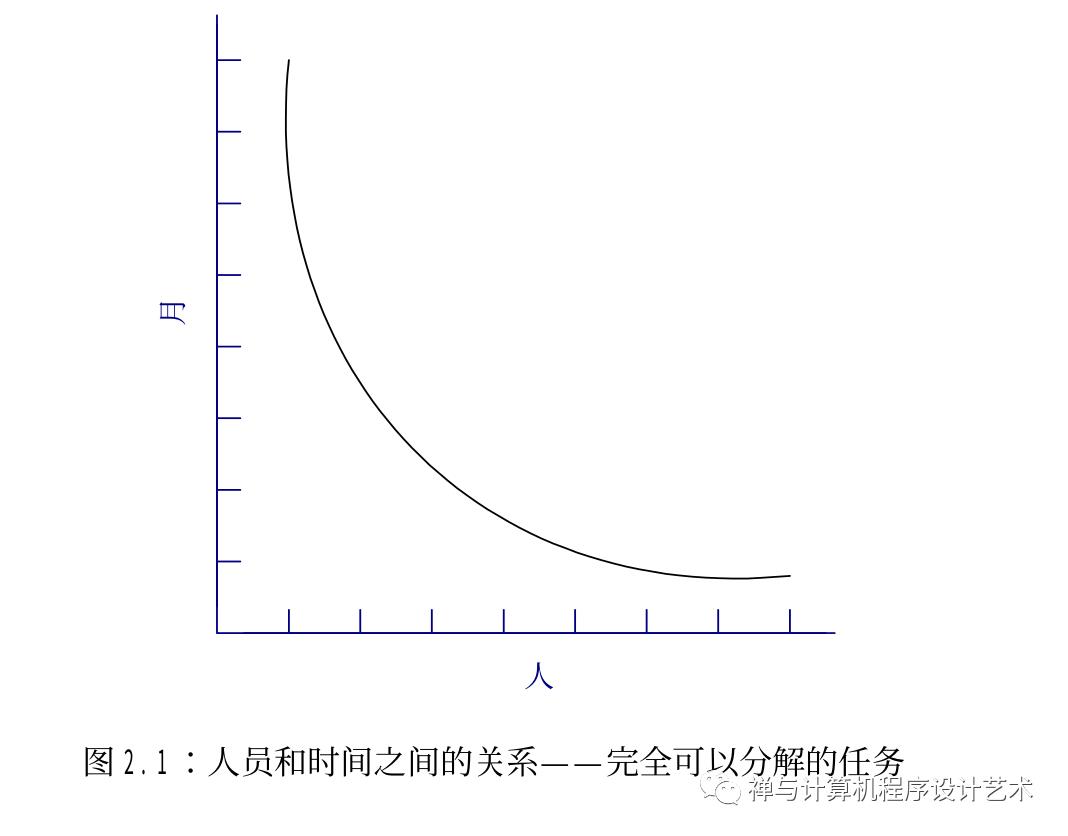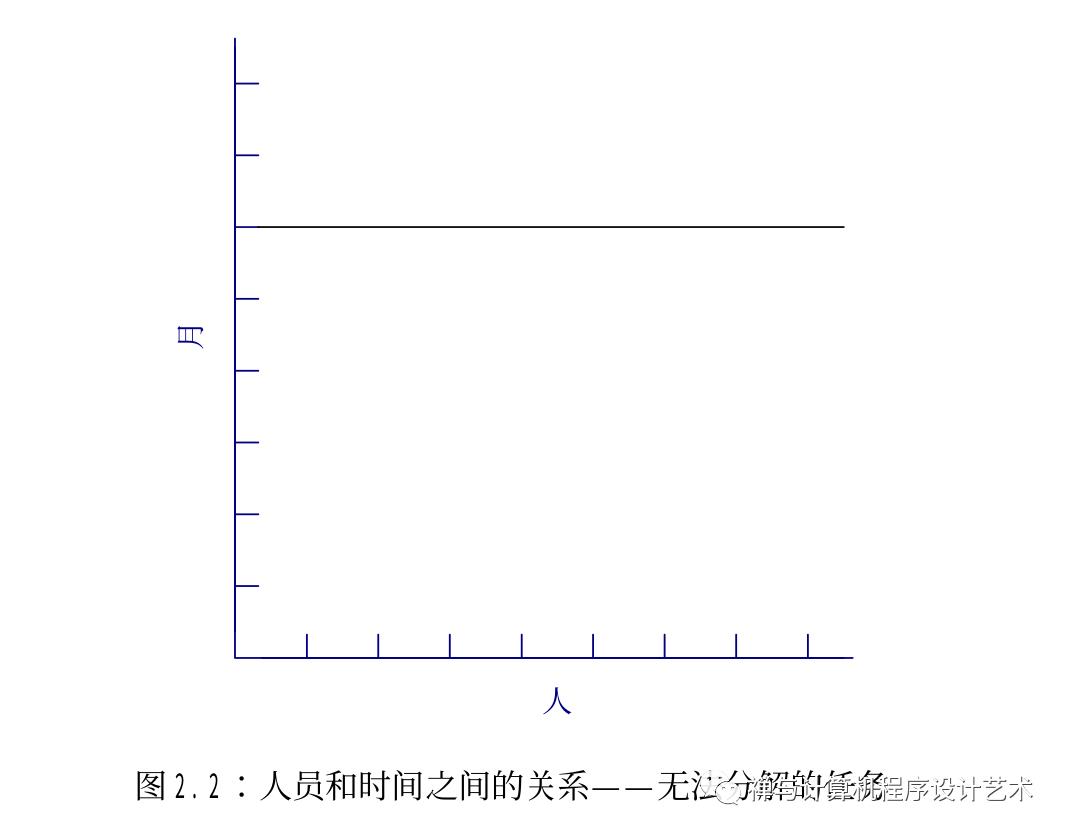《人月神话(The Mythical Man-Month)》2人和月可以互换吗?人月神话存在吗?
Posted 禅与计算机程序设计艺术
tags:
篇首语:本文由小常识网(cha138.com)小编为大家整理,主要介绍了《人月神话(The Mythical Man-Month)》2人和月可以互换吗?人月神话存在吗?相关的知识,希望对你有一定的参考价值。
美酒的酿造需要年头,美食的烹调需要时间;
片刻等待,更多美味,更多享受。
——新奥尔良 Antoine 餐厅的菜单
Good cooking fakes time.
If you are made to wait,
it is to serve you better, and to please you.
——MENU OF RESTAURANT ANTOINE. NEW ORLEANS

在众多软件项目中,缺乏合理的时间进度是造成项目滞后的最主要原因,它比其他所有因素加起来的影响还大。导致这种普遍性灾难的原因是什么呢?
More software projects have gone awry (出错;出岔子)for lack of calendar time than for all other causes combined. Why is this cause of disaster so common?
首先,我们对估算技术缺乏有效的研究,更加严肃地说,它反映了一种悄无声息,但并不真实的假设——一切都将运作良好。
First, our techniques of estimating are poorly developed. More seriously, they reflect an unvoiced assumption which is quite untrue, i.e., that all will go well.
第二,我们采用的估算技术隐含地假设人和月可以互换,错误地将进度与工作量相互混淆。
Second, our estimating techniques fallaciously confuse effort with progress, hiding the assumption that men and months are interchangeable.
第三,由于对自己的估算缺乏信心,软件经理通常不会有耐心持续地进行估算这项工作。
Third, because we are uncertain of our estimates, software managers often lack the courteous stubbornness of Antoine's chef.
第四,对进度缺少跟踪和监督。其他工程领域中,经过验证的跟踪技术和常规监督程序,在软件工程中常常被认为是无谓的举动。
Fourth, schedule progress is poorly monitored. Techniques proven and routine in other engineering disciplines are considered radical innovations in software engineering.
第五,当意识到进度的偏移时,下意识(以及传统)的反应是增加人力。这就像使用汽油灭火一样,只会使事情更糟。越来越大的火势需要更多的汽油,从而进入了一场注定会导致灾难的循环。
Fifth, when schedule slippage is recognized, the natural (and traditional) response is to add manpower. Like dousing a fire with gasoline, this makes matters worse, much worse. More fire requires more gasoline, and thus begins a regenerative cycle which ends in disaster.
进度监督是另一篇论文的主题,而本文中我们将对问题的其他方面进行更详细的讨论。
Schedule monitoring will be the subject of a separate essay. Let us consider other aspects of the problem in more detail.

乐观主义(Optimism)
所有的编程人员都是乐观主义者。可能是这种现代魔术特别吸引那些相信美满结局的人;也可能是成百上千琐碎的挫折赶走了大多数人,只剩下了那些习惯上只关注结果的人;还可能仅仅因为计算机还很年轻,程序员更加年轻,而年轻人总是些乐观主义者——无论是什么样的程序,结果是勿庸置疑的:
“这次它肯定会运行。” 或者 “我刚刚找出了最后一个错误。”
所以系统编程的进度安排背后的第一个假设是:一切都将运作良好,每一项任务仅花费它所“应该”花费的时间。
All programmers are optimists. Perhaps this modern sorcery especially attracts those who believe in happy endings and fairy godmothers. Perhaps the hundreds of nitty frustrations drive away all but those who habitually focus on the end goal. Perhaps it is merely that computers are young, programmers are younger, and the young are always optimists. But however the selection process works, the result is indisputable:
"This time it will surely run," or "I just found the last bug."
So the first false assumption that underlies the scheduling of systems programming is that all will go well, i.e., that each task will hike only as long as it "ought" to take.
对这种弥漫在编程人员中的乐观主义,理应受到慎重的分析。
The pervasiveness of optimism among programmers deserves more than a flip analysis.
Dorothy Sayers 在她的“The Mind of the Maker”一书中,将创造性活动分为三个阶段:构思、实现和交流。
Dorothy Sayers, in her excellent book, The Mind of the Maker, divides creative activity into three stages: the idea, the implementation, and the interaction.
书籍、计算机、或者程序的出现,首先是作为一个构思或模型出现在作者的脑海中,它与时间和空间无关。接着,借助钢笔、墨水和纸,或者电线、硅片和铁氧体,在现实的时间和空间中实现它们。然后,当某人阅读书本、使用计算机和运行程序的时候,他与作者的思想相互沟通,从而创作过程得以结束。
A book, then, or a computer, or a program comes into existence first as an ideal construct, built outside time and space, but complete in the mind of the author. It is realized in time and space, by pen, ink, and paper, or by wire, silicon, and ferrite. The creation is complete when someone reads the book, uses the computer, or runs the program, thereby interacting with the mind of the maker.
以上 Sayers 的阐述不仅仅可以描绘人类的创造性活动,而且类似于“基督的教义”(Christian doctrine),能指导我们的日常工作。对于创造者,只有在实现的过程中,才能发现我们构思的不完整性和不一致性。因此,对于理论家而言,书写、试验以及“工作实现”是非常基本和必要的。(所谓:纸上得来终觉浅,绝知此事要躬行。)
This description, which Miss Sayers uses to illuminate not only human creative activity but also the Christian doctrine of the Trinity, will help us in our present task. For the human makers of things, the incompletenesses and inconsistencies of our ideas become clear only during implementation. Thus it is that writing, experimentation, "working out" are essential disciplines for the theoretician.
在许多创造性活动中,往往很难掌握活动实施的介质,例如木头切割、油漆、电器安装等。这些介质的物理约束限制了思路的表达,它们同样对实现造成了许多预料之外的困难。
In many creative activities the medium of execution is intractable. Lumber splits(木头切割); paints smear(油漆); electrical circuits ring(电器安装). These physical limitations of the medium constrain the ideas that may be expressed, and they also create unexpected difficulties in the implementation.
由于物理介质和思路中隐含的不完善性,实际实现起来需要花费大量的时间和汗水。对遇到的大部分实现上的困难,我们总是倾向于去责怪那些物理介质,因为它们不顺应“我们”设定的思路。其实,这只不过是我们的骄傲使判断带上了主观主义色彩。
Implementation, then, takes time and sweat both because of the physical media and because of the inadequacies of the underlying ideas. We tend to blame the physical media for most of our implementation difficulties; for the media are not "ours" in the way the ideas are, and our pride colors our judgment.
然而,计算机编程基于十分容易掌握的介质,编程人员通过非常纯粹的思维活动——概念以及灵活的表现形式(concepts and very flexible representations)来开发程序。正由于介质的易于驾驭,我们期待在实现过程中不会碰到困难,因此造成了乐观主义的弥漫(pervasive optimism)。而我们的构思是有缺陷的,因此总会有 bug。也就是说,我们的乐观主义并不应该是理所应当的。
Computer programming, however, creates with an exceedingly tractable medium. The programmer builds from pure thought-stuff: concepts and very flexible representations thereof. Because the medium is tractable, we expect few difficulties in implementation; hence our pervasive optimism. Because our ideas are faulty, we have bugs; hence our optimism is unjustified.
在单个的任务中,“一切都将运转正常”的假设,在时间进度上具有可实现性。因为所遇的延迟是一个概率分布曲线,“不会延迟”仅具有有限的概率,所以现实情况可能会像计划安排的那样顺利。然而大型的编程工作,或多或少包含了很多任务,某些任务间还具有前后的次序,从而一切正常的概率变得非常小,甚至接近于无。
In a single task, the assumption that all will go well has a probabilistic effect on the schedule. It might indeed go as planned or there is a probability distribution for the delay that will be encountered, and "no delay" has a finite probability. A large programming effort, however, consists of many tasks, some chained end-to-end. The probability that each will go well becomes vanishingly small.
人月(The Man-Month)
第二个谬误的思考方式,是在估计和进度安排中使用的工作量单位:人月。
成本的确随开发产品的人数和时间的不同,有着很大的变化,进度却不是如此。因此我认为用人月作为衡量一项工作的规模是一个危险和带有欺骗性的神话。它暗示着人员数量和时间是可以相互替换的。
The second fallacious thought mode is expressed in the very unit of effort used in estimating and scheduling: the man-month.
Cost does indeed vary as the product of the number of men and the number of months. Progress does not. Hence the man-month as a unit for measuring the size of a job is a dangerous and deceptive myth. It implies that men and months are interchangeable.
人数和时间的互换仅仅适用于以下情况:某个任务可以分解给参与人员,并且他们之间不需要相互的交流(图 2.1)。这在割小麦或收获棉花的工作中是可行的;而在系统编程中近乎不可能。
Men and months are interchangeable commodities only when a task can be partitioned among many workers with no communication among them (Fig. 2.1). This is true of reaping wheat or picking cotton; it is not even approximately true of systems programming.

当任务由于次序上的限制不能分解时,人手的添加对进度没有帮助(图 2.2)。无论多少个母亲,孕育一个生命都需要十个月。
When a task cannot be partitioned because of sequential constraints, the application of more effort has no effect on the schedule (Fig. 2.2). The bearing of a child takes nine months, no matter how many women are assigned.
由于调试、测试的次序特性,许多软件都具有这种特征,
Many software tasks have this characteristic because of the sequential nature of debugging.

对于可以分解,但子任务之间需要相互沟通和交流的任务,必须在计划工作中考虑沟通的工作量。因此,相同人月的前提下,采用增加人手来减少时间得到的最好情况,也比未调整前要差一些(图 2.3)。
In tasks that can be partitioned but which require communication among the subtasks, the effort of communication must be added to the amount of work to be done. Therefore the best that can be done is somewhat poorer than an even trade of men for months (Fig. 2.3).

沟通所增加的负担由两个部分组成,培训和相互的交流。每个成员需要进行技术、项目目标以及总体策略上的培训。这种培训不能分解,因此这部分增加的工作量随人员的数量呈线性变化 。
The added burden of communication is made up of two parts, training and intercommunication. Each worker must be trained in the technology, the goals of the effort, the overall strategy, and the plan of work. This training cannot be partitioned, so this part of the added effort varies linearly with the number of workers.
相互之间交流的情况更糟一些。如果任务的每个部分必须分别和其他部分单独协作,则工作量按照 n(n-1)/2 递增。一对一交流的情况下,三个人的工作量是两个人的三倍,四个人则是两个人的六倍。而对于需要在三四个人之间召开会议、进行协商、一同解决的问题,情况会更加恶劣。所增加的用于沟通的工作量可能会完全抵消对原有任务分解所产生的作用,此时我们会被带到图 2.4 的境地。
Intercommunication is worse. If each part of the task must be separately coordinated with each other part/ the effort increases as n(n-I)/2. Three workers require three times as much pairwise intercommunication as two; four require six times as much as two. If, moreover, there need to be conferences among three, four, etc., workers to resolve things jointly, matters get worse yet. The added effort of communicating may fully counteract the division of the original task and bring us to the situation of Fig. 2.4.

因为软件开发本质上是一项系统工作——错综复杂关系下的一种实践——沟通、交流的工作量非常大,它很快会消耗任务分解所节省下来的个人时间。从而,添加更多的人手,实际上是延长了,而不是缩短了时间进度。
Since software construction is inherently a systems effort—an exercise in complex interrelationships—communication effort is great, and it quickly dominates the decrease in individual task time brought about by partitioning. Adding more men then lengthens, not shortens, the schedule.
系统测试(Systems Test)
在时间进度中,顺序限制所造成的影响,没有哪个部分比单元调试和系统测试所受到的牵涉更彻底。而且,要求的时间依赖于所遇到的错误、缺陷数量以及捕捉它们的程度。理论上,缺陷的数量应该为零。但是,由于我们的乐观主义,通常实际出现的缺陷数量比预料的要多得多。因此,系统测试进度的安排常常是编程中最不合理的部分。
No parts of the schedule are so thoroughly affected by sequential constraints as component debugging and system test. Furthermore, the time required depends on the number and subtlety of the errors encountered. Theoretically this number should be zero. Because of optimism, we usually expect the number of bugs to be smaller than it turns out to be. Therefore testing is usually the most mis-scheduled part of programming.
对于软件任务的进度安排,以下是我使用了很多年的经验法则:
For some years I have been successfully using the following rule of thumb for scheduling a software task:
1/3 计划 (planning)
1/6 编码 (coding)
1/4 构件测试和早期系统测试 (component test and early system test)
1/4 系统测试,所有的构件已完成 (system test, all components in hand.)
在许多重要的方面,它与传统的进度安排方法不同:
1. 分配给计划的时间比寻常的多。即便如此,仍不足以产生详细和稳定的计划规格说明,也不足以容纳对全新技术的研究和摸索。
2. 对所完成代码的调试和测试,投入近一半的时间,比平常的安排多很多。
3. 容易估计的部分,即编码,仅仅分配了六分之一的时间。
通过对传统项目进度安排的研究,我发现很少项目允许为测试分配一半的时间,但大多数项目的测试实际上是花费了进度中一半的时间。它们中的许多项目,在系统测试之前还能保持进度。或者说,除了系统测试,进度基本能保证 。
特别需要指出的是,不为系统测试安排足够的时间简直就是一场灾难。因为延迟发生在项目快完成的时候。直到项目的发布日期,才有人发现进度上的问题。因此,坏消息没有任何预兆,很晚才出现在客户和项目经理面前。
另外,此时此刻的延迟具有不寻常的、严重的财务和心理上的反应。在此之前,项目已经配置了充足的人员,每天的人力成本也已经达到了最大的限度。更重要的是,当软件用来支持其他的商业活动(计算机硬件到货,新设备、服务上线等等)时,这些活动延误出现即将发布前,那么将付出相当高的商业代价。
实际上,上述的二次成本远远高于其他开销。因此,在早期进度策划时,允许充分的系统测试时间是非常重要的。
Indeed, these secondary costs may far outweigh all others. It is therefore very important to allow enough system test time in the original schedule.
空泛的估算
观察一下编程人员,你可能会发现,同厨师一样,某项任务的计划进度,可能受限于顾客要求的紧迫程度,但紧迫程度无法控制实际的完成情况。就像约好在两分钟内完成一个煎蛋,看上去可能进行得非常好。但当它无法在两分钟内完成时,顾客只能选择等待或者生吃煎蛋。软件顾客的情况类似。
厨师还有其他的选择:他可以把火开大,不过结果常常是无法“挽救”的煎蛋——一面已经焦了,而另一面还是生的。
现在,我并不认为软件经理内在的勇气和坚持不如厨师,或者不如其他工程经理。但为了满足顾客期望的日期而造成的不合理进度安排,在软件领域中却比其他的任何工程领域要普遍得多。而且,非阶段化方法的采用,少得可怜的数据支持,加上完全借助软件经理的直觉,这样的方式很难生产出健壮可靠和规避风险的估计。
显然我们需要两种解决方案。开发并推行生产率图表、缺陷率、估算规则等等,而整个组织最终会从这些数据的共享上获益。
或者,在基于可靠基础的估算出现之前,项目经理需要挺直腰杆,坚持他们的估计,确信自己的经验和直觉总比从期望派生出的结果要强得多。
重复产生的进度灾难
当一个软件项目落后于进度时,通常的做法是什么呢?自然是加派人手。如图 2.1 至2.4 所示,这可能有所帮助,也可能无法解决问题。
我们来考虑一个例子 。设想一个估计需要 12 个人月的任务,分派给 3 个成员 4 个月时间,在每个月的末尾安排了可测量的里程碑 A、B、C、D(图 2.5)。
现在假定两个月之后,第一个里程碑没有达到(图 2.6)。项目经理面对的选择方案有哪些呢?
1. 假设任务必须按时完成。假设仅仅是任务的第一个部分估计不得当,即如图 2.6所示,则剩余了 9 个人月的工作量,时间还有两个月,即需要 4.5 个开发人员,所以需要在原来 3 个人的基础上增加 2 个人。
2. 假设任务必须按时完成。假设整个任务的估计偏低,即如图 2.7 所示,那么还有18 个人月的工作量以及 2 个月的时间,需要将原来的 3 个人增至 9 个人。
3. 重新安排进度。我喜欢 P.Fagg,一个具有丰富经验的硬件工程师的忠告:
“避免小的偏差(Take no small slips)”。
也就是说,在新的进度安排中分配充分的时间,以确保工作能仔细、彻底地完成,从而无需重新确定时间进度表。
4. 削减任务。在现实情况中,一旦开发团队观察到进度的偏差,总是倾向于对任务进行削减。当项目延期所导致的后续成本非常高时,这常常是唯一可行的方法。项目经理的相应措施是仔细、正式地调整项目,重新安排进度;或者是默默地注视着任务项由于轻率的设计和不完整的测试而被剪除。


前两种情况中,坚持把不经调整的任务在四个月内完成将是灾难性的。考虑到重复生成的工作量,以第一种为例(图 2.8)——不论在多短的时间内,聘请到多么能干的两位新员工,他们都需要接受一位有经验的职员的培训。如果培训需要一个月的时间,那么三个人月将会投入到原有进度安排以外的工作中。另外,原先划分为三个部分的工作,会重新分解成五个部分;某些已经完成的工作必定会丢失,系统测试必须被延长。因此,在第三个月的月末,仍然残留着 7 个人月的工作,但此时只有 5 个有效的人月。如同图 2.8 所示,产品还是会延期,如同没有增加任何人手(图 2.6)。
期望四个月内完成项目,仅仅考虑培训的时间,不考虑任务的重新划分和额外的系统测试,在第二个月末需要增添 4 个,而不是 2 个人员。如果考虑任务划分和系统测试的工作量,则还需要继续增加人手。到那时所拥有的就不是 3 人的队伍,而是 7 人以上的团队;并且小组的组织和任务的划分在类型上都不尽相同,这已经不是程度上的差异问题。
注意在第三个月的结尾时,情况看上去还是很糟。除去管理的工作不谈,3 月 1 日的里程碑仍未达到。此时,对项目经理而言,仍然存在着很强的诱惑——添加更多人力,结果往往会是上述循环的重复。这简直就是一种疯狂、愚蠢的做法。
Notice that by the end of the third month things look very black. The March 1 milestone has not been reached in spite of all the managerial effort. The temptation is very strong to repeat the cycle, adding yet more manpower. Therein lies madness.
前面的讨论仅仅是第一个里程碑估计不当的情况。如果在 3 月 1 日,项目经理做出了比较保守的假设,即整个估计过于乐观了,如图 2.7 所示。6 个人手需要添加到原先的任务中。培训、任务的重新分配、系统测试工作量的计算作为练习留给读者。但是毫无疑问,重现“灾难”所开发出的产品,比没有增加人手,而是重新安排开发进度所产生的产品更差。
The foregoing assumed that only the first milestone was misestimated. If on March I one makes the conservative assumption that the whole schedule was optimistic, as Fig. 2.7 depicts, one wants to add 6 men just to the original task. Calculation of the training, repartitioning, system testing effects is left as an exercise for the reader. Without a doubt, the regenerative disaster will yield a poorer product, later, than would rescheduling with the original three men, unaugmented.
简单、武断地重复一下 Brooks 法则:
向进度落后的项目中增加人手,只会使进度更加落后。
Oversimplifying outrageously, we state Brooks's Law:
Adding manpower to a late software project makes it later.
这就是除去了神话色彩的人月。项目的时间依赖于顺序上的限制,人员的数量依赖于单个子任务的数量。从这两个数值可以推算出进度时间表,该表安排的人员较少,花费的时间较长(唯一的风险是产品可能会过时)。
相反,分派较多的人手,计划较短的时间,将无法得到可行的进度表。
总之,在众多软件项目中,缺乏合理的时间进度是造成项目滞后的最主要原因,它比其他所有因素加起来的影响还要大。
This then is the demythologizing of the man-month. The number of months of a project depends upon its sequential constraints. The maximum number of men depends upon the number of independent subtasks. From these two quantities one can derive schedules using fewer men and more months. (The only risk is product obsolescence.)
One cannot, however, get workable schedules using more men and fewer months.
More software projects have gone awry for lack of calendar time than for all other causes combined.

【更多阅读】
【图文详解】一文全面彻底搞懂HBase、LevelDB、RocksDB等NoSQL背后的存储原理:LSM-tree日志结构合并树
Redis 作者 Antirez 讲如何实现分布式锁?Redis 实现分布式锁天然的缺陷分析&Redis分布式锁的正确使用姿势!
十年技术进阶路:让我明白了三件要事。关于如何做好技术 Team Leader?如何提升管理业务技术水平?(10000字长文)
以上是关于《人月神话(The Mythical Man-Month)》2人和月可以互换吗?人月神话存在吗?的主要内容,如果未能解决你的问题,请参考以下文章
悼念《人月神话》(The Mythical Man-Month)作者 Fred Brooks
《人月神话》(The Mythical Man-Month)6贯彻执行(Passing the Word)
经典传颂人月神话The Mythical Man-Month
《人月神话》(The Mythical Man-Month)3 外科手术队伍(The Surgical Team)
《人月神话》8 胸有成竹(Chaptor 8.Calling the Shot -The Mythical Man-Month)